|
|
|
|||
|
|
||||
|
|
||||
| The (Jet)X Files | ||||
|
|
HOME | SITE MAP | FORUM | CONTACT |
|
||
|
ABOUT | MOTORS | MODELS | ARCHIVE | HISTORY | STORE | FAQ | LINKS
|
|
|
|
|
|
|||||||||||||||||||||||||||||||||||||||||||||||||||||||||||||||||||||
|
The (Jet)X Files 19
for July 2004
by Roger Simmonds Reprinted from SAM 35 Speaks, July 2004 Afterburning After my request for an assessment of Benson-Ball’s miniature jet engines in May’s article, John Scott-Scott kindly provided an informal analysis of the X-J-E/20 three-stage axial turbine illustrated in the 1954 Aeromodeller Annual article (see (Jet)X Files, March 2004). John begins: “If we assume a 6.5" diameter and 26,000 rpm, the mean blade speed (at about 5.3" diameter) is about 600 ft/sec. This is quite fast and would impose very high stress on the blade roots and discs. In comparison, the Armstong-Siddley Python, on which enormous sums had been spent in development, had 11 stages at a lower blade speed. The bearing locations and arrangement do not lend themselves to high speed or high temperature operation; even today, ceramic bearings cope, but only just. The combustion chamber lacks a ‘proper’ flame stabiliser, so burning would be wherever it suited, but very likely it would only be stabilised on the turbine stator. Would that jet engine design could be so simple, but, particularly with axial compressors, life is not like that! Miniature axial flow bladings are notoriously inefficient; all today’s model gas turbines use centrifugal compressors for good aerodynamic reasons and they also run faster”. In summary, therefore, as a ‘doodle’ the sketch is fine, but in reality it is no more than that, so we must conclude that Mr Ball used some form of ducted fan”. John also has doubts about the R/C system; “Ball claims to have had a 10 channel radio fitted! Even our early reed sets had not evolved by then”. John concludes, “It’s a good story … the shapes (of his model aeroplanes) are worth replicating with modern R/C and fan units”. |
|
|||||||||||||||||||||||||||||||||||||||||||||||||||||||||||||||||||||
|
I’m tempted to leave the BB saga there: as one correspondent said, “If true, it’s the greatest aeromodelling story ever told; if only partially true, why the exaggerations?”. Benson-Ball was not alone in claiming a working model turbojet in the early years post-WWII, and the advert on the right comes from a 1948 Model Airplane News. The design boasts a centrifugal compressor, which is a step in the right direction, but I wonder how many were made from the plans and I doubt it could have been either self-sustaining or provide a usable thrust. However, I’m sure it made a wonderful whine when turned over! I recently came across the Gamages Jetex advertisement [below right] in Meccano Magazine, May 1949. It is interesting as the earliest I have found that includes the Jetex 50. Incidentally, what became of Meccano Magazine? I seem to remember it featured simple Jetex models well into the sixties when the mainstream Aeromodeller and Model Aircraft had all but abandoned Jetex propulsion. Somewhat stung by Stan Pearson’s remark, “jet planes with stringers? I ask you!”, I have been looking for a jet/rocket plane where a fabric covered open structure is not incongruous. There was of course the rocket-assisted Opel Sander Rak-12, a model of which for Jetex 50 was published in Model Aircraft, March 1956. This design has appeared in SAM 35 Speaks at least once before, and Chris Strachan has made a 13'' version for the Rapier L1. Chris is quoted (Aeromodeller, Nov 2002), “Since building the model I have done a lot of searching for information on early rocket aircraft. This model is wildly inaccurate. The Rak was very high aspect ratio, and it should have about twice this span”. There was a rather better realisation of the Rak-12 (also for Jetex 50) by Walter A. Musciano in the US. I thought it might be possible to go back even further than 1929 when the wonderfully named Fritz von Opel first steered his Rak-12 down a ramp and up to 50 feet and 90 mph, and remembered the Rumanian-born Henri Coanda claimed to have made the World’s first ‘jet-propelled’ flight in 1910. Hmm… I looked for data about Coanda’s prototype without much success, and the rather poor illustration [below] (from a 1950’s Royal Air Force Flying Review) is the only one I have been able to find. I have cleaned the photo up a bit and hope the definition is adequate. 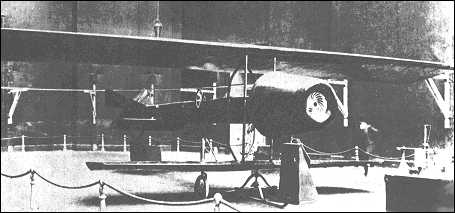
Coanda apparently believed the conventional ‘dragging’ motion of a propeller could be bettered by ‘creating a vacuum in front of the aeroplane into which it could be drawn’ (?), and this remarkable aircraft, which also included a cruciform tail unit and retractable undercarriage amongst its idiosyncracies, had a very strange motor at the sharp end. Coanda called this a ‘turbo-propulsor’. It was, perhaps, more in the nature of a ducted fan, (and a model would be more suited to EDF), but he did plan to ignite fuel in its innards and derive some jet reaction. There was, apparently, one short test hop, or rather, ‘test crash’, though this was without the benefit of jet augmentation. After this disappointment, Coanda, a poor pilot by his own admission, went on to more significant and lucrative research. The contemporaneous advert shows only the wing planform of the aircraft. Does any reader have any more details? By the way, ‘Aéroplanes sans hélices’ sounds like a good alternative title for The (Jet)X Files! I received an interesting email from John Harvey; “There is no ‘Vintage Rocket Society’ as such (see April’s column), but SERFS (Southern England Rocket Fliers) fly everything as long as it is safe and fun. The Estes catalogue has lists of model lift-off weight against motor that will indicate a suitable motor for the Wilmot Mansour Dan Dare Space ship. There are other motors, Quest for example”. The Estes website is somewhat daunting, and Grif Ingram recommends Ye Olde Rocket Shoppe website, which I will peruse for a motor equivalent to the 50R (about 1500 mN for 5 seconds), as I quite fancy Ian Gedde’s Coccinellida (Aeromodeller, Nov. 1956). John also comments on the IMA target drone (see April’s ‘Gliderscope’); “I have one in good condition, and now that a variety of high power motors are available I am sure I could fly it as it was meant to be … but getting it down safely, that’s the problem, I don’t want it to be a ‘one off’ spectacular!” I hope John remembers the original was launched using a bungee powered ramp. |

- Model Airplane News, 1948

- Meccano Magazine, May 1949 (p. iv)

- Royal Air Force Flying Review, 1950
|
|||||||||||||||||||||||||||||||||||||||||||||||||||||||||||||||||||||
After seeing the Draken for Rapier L2 in April's column, Sten Perrson sent me plan of Sigurd Isacson's SAAB 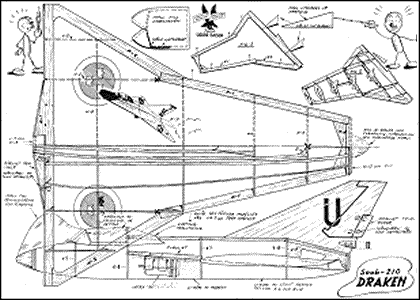
Sten comments, "As with other Isacson Jetex designs, the Isacson's 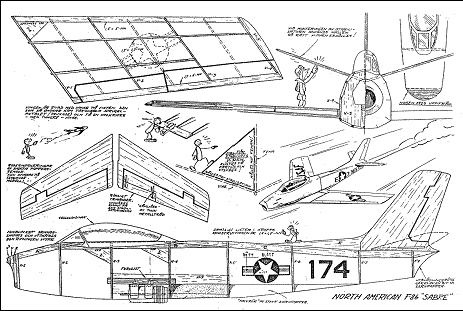
The Jetex 50 might be a little too forward, and the fuselage could do with a few more stringers, but this is a nice model with some similarities to Albert Hatfull's KeilKraft design. Note the minimal dihedral and the tailplane trim tab. |
 |
|||||||||||||||||||||||||||||||||||||||||||||||||||||||||||||||||||||
|
Isacson's designs may be 'stand-way-back' scale, but, as can be seen from Chris's Draken (right), resplendent in the silver and red trim of the prototype, the spirit of the 'real thing' has been effectively captured and it flies very well indeed. If any reader would like a copy of the Remember, however, that these fifties' plans are derived from second generation or even third generation photocopies, and may have suffered copying distortion over the years, as early photocopiers were notoriously bad in this respect. Look carefully at the Sabre plan: you will see that the two sheets from which the plan was reconstructed not quite match. Sometimes the distortion is not this obvious, and it was only after I had made both wings for my Skyleada Hunter that I discovered the wing roots mismatched by 1/8th of an inch at the root rib. This was too much to be 'fudged', I'm afraid, even by an experienced 'bodger' like myself, so the starboard wing had to be remade using the reverse of the port wing. For a glacially slow builder like me, this represented a day's work. |
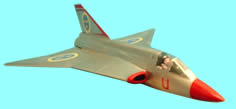
- photo by Chris Strachan
|
|||||||||||||||||||||||||||||||||||||||||||||||||||||||||||||||||||||
|
Jason Willbourn, who has also made a Skyleada Hunter, didn't complain of distorted wings, and perhaps his plan was OK, but it is best to check the accuracy and matching of components before building, and redraw if necessary. Small jet planes achieve quite high velocities, and accurate alignment of flying surfaces (and thrust line) is important. For models with a horizontal keel (à la Bill Dean), aligning wings and tail is comparatively straightforward, the keel providing a useful datum, but where there is a vertical keel and mid wings, making a set-up jig similar those included in the Jetex tailored kits (see right) makes good sense. So that nothing is wasted, this can be incorporated in your carrying box (you do make these, don't you?) afterwards. What Sten says about Sigurd Isacson's models is also true of the Jetex 'Flying Scale' models from Veron, KeilKraft and Skyleada, and perhaps the rude remarks I have made about some of these are unfair. Amerang no longer make any KK kits, but Easy Built kits are still listed in the Sams Models catalogue. 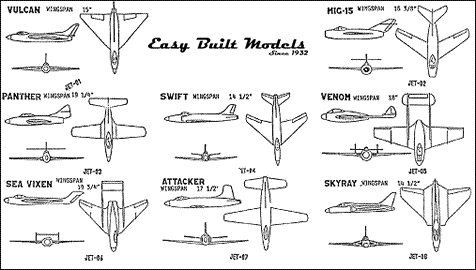
I am not sure of the origin of these transatlantic offerings, but they may be fifties' designs adapted and slightly enlarged for the Powermax Jet-X 50, which was rated at 0.7 oz (˜220mN) thrust. For example, the Easy Built MiG 15 (which is not Bill Dean's design) is quoted as 16 |
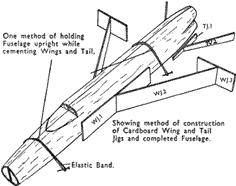 |
|||||||||||||||||||||||||||||||||||||||||||||||||||||||||||||||||||||
|
On the right is Howard Metcalfe's Easy Built Swift. Howard writes: "It is 14.5'' span and weighs 38g with a used Rapier L2. It is finished with Airspan heatshrink covering and airbrushed in artist's acrylics. The air intakes and canopy are modelled on the speed record holder rather than the first prototypes [it is light blue with hand painted roundels]. I have lengthened the air intakes and added soft The Easy Built range, then, is well worth exploring. Though the kits appear rather unappealing and a trifle basic at first sight, with a little care and detail modification they can be made into very nice looking models. Catapult Jets Stan Pearson need make no apology about these sorts of models, which have a long and honourable history. For example, A. G. Piell published a nice article, 'Catapult Solids' (Aeromodeller, Jan. 1954) that featured the 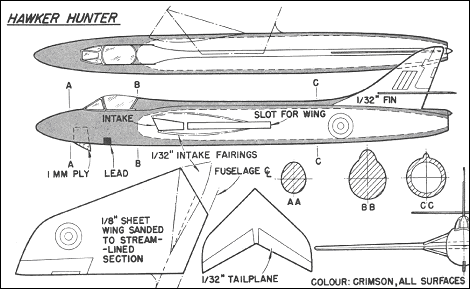
Note that Mr Piell also prefers a plain finish for his Hunter. The AM staff were clearly quite taken by his designs: "Two models sent to the editorial offices were soon put through their paces, amazing all with a rate of climb second only to the real thing. What's more … they glide!" As well as the Hunter, APS offered Piell's ( |
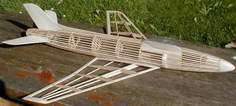 
- photos by Howard Metcalfe
|
|||||||||||||||||||||||||||||||||||||||||||||||||||||||||||||||||||||
|
These diminutive models were fired off using a well-stretched loop of Stan is our own doyen of the genre, and has me a selection of photos from his vintage collection of As can be seen, these are true scale 'flying solids' devoid of stringers, though still capable of an excellent performance (Stan tells me he lost several OOS in thermals). It would be good to see catapult jets at our meetings, so if any reader has any copies of Mr Piell's APS plans I would love to hear from you. |
 
- photos by Stan Pearson
|
|||||||||||||||||||||||||||||||||||||||||||||||||||||||||||||||||||||
|
|
||||||||||||||||||||||||||||||||||||||||||||||||||||||||||||||||||||||
|
|
|
|||||||||||||||||||||||||||||||||||||||||||||||||||||||||||||||||||||
|
|
|
|
|
|
|
|
Acknowledgements - Article: Roger Simmonds - Illustrations: Roger Simmonds, Chris Strachan, Howard Metcalfe, Stan Pearson |
|
|
|
|
ABOUT | MOTORS | MODELS | ARCHIVE | HISTORY | STORE | FAQ | LINKS |
|
|
Terms of Use
|
Queries? Corrections? Additions?
Please
contact us.
|
|